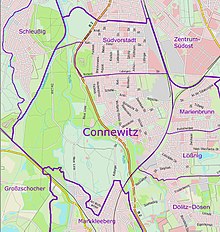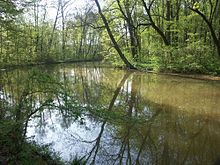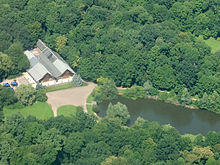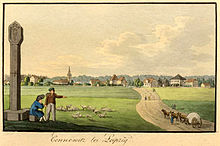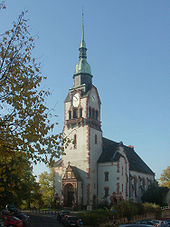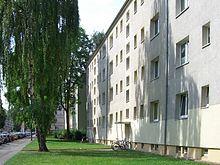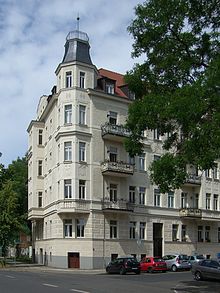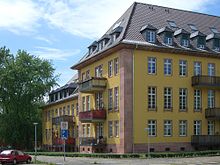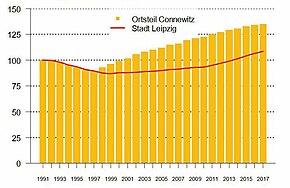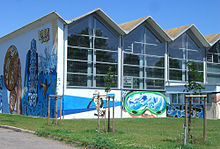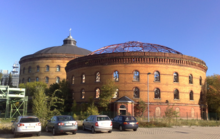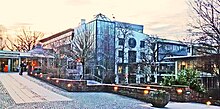Connewitz
|
Connewitz district of Leipzig |
|
|---|---|
| Coordinates | 51 ° 18 '36 " N , 12 ° 22' 24" E |
| height | 122 m |
| surface | 7.39 km² |
| Residents | 18,989 (Dec. 31, 2018) |
| Population density | 2570 inhabitants / km² |
| Incorporation | Jan. 1, 1891 |
| Postcodes | 04277, 04275 |
| prefix | 0341 |
| Borough | south |
| Transport links | |
| Federal road |
|
| Train | S 4 S 5 S 5X S 6 |
| tram | 9, 10, 11, N10 |
| bus | 70, 79, 89, 107, 412; Night buses: N9 |
| Source: District catalog of the city of Leipzig 2018 | |
Connewitz is a district of Leipzig . An independent municipality until 1891, today Connewitz is a district in the southern district of Leipzig according to the municipal structure (official district number: 41). Connewitz has an area of 7.39 km² with 18,989 inhabitants (as of December 31, 2018). With a large proportion of the Leipzig alluvial forest , Connewitz is the most densely wooded district. Connewitz is a particularly diverse district of Leipzig in terms of both urban planning and the social composition of the population.
geography
location
Connewitz is about three kilometers south of Leipzig city center. The area includes alluvial forest areas and the former field corridor east of it and up to ten meters higher. Only this is built on.
The boundaries of the district form the Schleußiger Weg, Wundtstrasse and Richard-Lehmann-Strasse in the north . The east and south-east border is the Bayerischer Bahnhof-Markkleeberg railway line . In the south, the built-up area of Markkleeberg is the border. Here, however, a few short streets at the so-called Wolfswinkel in an isolated location belong to Connewitz. To the west, the railway line Plagwitz-Markkleeberg West and the dam follow the high tide bed of the Elster and the West bank of the Elster flood bed .
The neighboring districts are from the north clockwise the Südvorstadt , Marienbrunn , Lößnig , Dölitz - Dosen , Markkleeberg (independent town), Großzschocher , Kleinzschocher and Schleußig .
Forest and water
With 384 hectares of forest (that is 53 percent of its area) Connewitz owns the largest proportion of forest in the Leipzig districts. This forest, the Connewitz wood, forms the main part of the southern Leipzig floodplain forest as a contiguous area . It is used both for forestry and for recreational purposes. In addition to a dense network of foot, bike and riding trails, there is also the Leipzig Wildlife Park , which shows native animal species in particular. Sports and dining facilities are also available.
Historically, Connewitzer Holz and the Dölitzer Holz on the right bank of the Pleiße, on the other side of the southeastern boundary, form the Leipziger Ratsholz . Before the village grew together with Ötzsch and Dölitz at the beginning of the 20th century, this forest area was only interrupted by a few meadows.
The Connewitzer Holz forest district is divided, on the left of Pleiße and Batschke-Floßgraben in Beipert and Probstei , between Floßgraben and Pleiße in Pfarrholz , Haken , Wolfswinkel , Langes Feld , Dachsbau , Horst , Gautzscher Spitze and Siebenacker and on the right of the Pleiße in Streitholz , stamp , Mühlholz and the Apitzsch , each starting from the north.
The Pleiße runs through the Connewitzer Holz from south to north in full length. As early as the first half of the 13th century, the three villages of Dölitz , Lößnig and Connewitz jointly dug a ditch branching off from the Pleiße to operate their mills, the Mühlpleiße , which today still runs with minor changes in the border area between forest and settlement area the hook bridge opens into the Pleiße. Shortly before, opens the left side in the region of the former Virgin laugh muzzle the splices flood bed in the splices.
About 150 meters further on, Panichs Lache flows out on the left and about 350 meters further on, also coming from the left, the Batschke , usually called Floßgraben in Leipzig . The Batschke was formerly a branch of the White Elster near Zwenkau and was used to raft firewood over the White Elster to Leipzig. The connection to the Elster was interrupted by the lignite mining. Today the raft ditch gets its water from the Cospudener See . It thus represents the connection between the Leipzig waters and the Cospudener See and has been usable for continuous boat traffic since the completion of a bridge in Markkleeberg.
Further to the west there is next to numerous oxbow lakes and pools, another watercourse, the Paußnitz . It is a former tributary of the Batschke, has been fed with Elster water via the border ditch since the interruption by the lignite opencast mining and flows into the Elster flood bed. The latter forms the western border of Connewitz. It was created for flood protection reasons and, like the Pleiße, is used for water sports. Still in Connewitz, the Pleißemühlgraben branches off at the Pleißewehr , which runs through the southern suburbs to the city center.
In historical times there were still two watercourses east of the Pleiße in Connewitz. The Trenkengraben (also Tränkengraben ) came from Probstheida via the Connewitzer Flur (now Marienbrunn) and the Hildebrandtstrasse area to Mühlpleiße. Today it is piped and integrated into the Leipzig sewage network. The second was the Domgraben , from the Marienquelle (near the Völkerschlachtdenkmal) roughly along today's Richard-Lehmann-Strasse to the west to Heilemannstrasse and then to the south into the former Streitteich. The only thing that reminds of the cathedral moat today are the recesses on the south side of Richard-Lehmann-Strasse and between Heilemannstrasse and Fockestrasse.
The Streitteich in the area of today's Teichstrasse was the largest of nine Connewitz ponds, most of which were located in the course of the Trenkengraben. The low location of the allotment gardens on Burgstädter Strasse still indicates the former poplar pond near Bornaische Strasse. The Connewitz village pond was located at the confluence of Probstheidaer Strasse and Prinz-Eugen-Strasse. Today in the district of Connewitz only the hook pond, newly created in the early 1970s, at the wildlife park restaurant, the smaller frog pond within the wildlife park and a pond between the development of the Prinz-Eugen-Strasse and the Mühlpleiße with connection to it still exist.
history
The village of Connewitz
Settlement in the place of today's place is already documented for the Iron Age.
After the Great Migration, Sorbian settlers founded the place Connewitz ( Old Sorbian : Konowica = "horse place", "place where horses graze") probably after the seventh century. The town center was located as a round at the triangle of today's Prinz-Eugen-, Probstheidaer and Biedermannstraße. The place developed in a north-westerly direction to the edge of the Pleißeauen until it merged with the local Sorbian settlement Döbschütz (later upper and lower village) to a long-drawn-out cul - de - sac village . From around the eleventh century, the Sorbian population was assimilated by the German settlers in a long process in the course of the German expansion to the east and the peasant land acquisition . A manor was built in the upper village (around 1100 Ritter von Kunawitz).
Between 1200 and 1250, the villages of Dölitz, Lößnig and Connewitz jointly built the approximately four-kilometer-long Mühlgraben (Mühlpleiße) to operate their mills. In 1275/76 the Augustinian Canons' Monastery in Leipzig came into possession of the manor and the rights to the Döbschützer mill. This expanded its operations in the 15th century. A copper hammer and a grinder were added to the grinding, oil and spice mill. At the fork in the road north of Connewitz, a wooden cross was erected in 1496 by the city of Leipzig as a soft symbol, which was replaced in 1536 by a stone column with a cross ( Connewitz cross ). The stone column from 1536 that is still preserved is in the Leipzig City History Museum .
After the Reformation , the City Council of Leipzig bought the Connewitz estate in 1543 and set up four threshing estates in 1545. The village of Connewitz, which until the Reformation was part of the Holy Cross Chapel in Ölschwitz , was parish off to Probstheida. In 1563 the Connewitz forestry was established.
1619–1629 17 farm workers' houses were built next to the mill, the Connewitz Neudörfchen, which separated from Connewitz in 1705, but "came back" in 1839. During the Thirty Years' War , troops passed through and pillaged and pillaged. In 1755/56 the (old) Connewitz cemetery was built near the cross and in 1770/71 a small late baroque church was built in the Oberdorf on the Schulberg , which remained a branch church of Probstheida until 1875 .
During the Battle of the Nations near Leipzig , troops of the Napoleonic army barricaded themselves in Connewitz, which suffered severe damage from bitter fighting. At the beginning of the 19th century, wealthy Leipzig citizens discovered the beautiful location of Connewitz and built country houses here . In the Schumann's "Lexicon of Saxony" continued by Albert Schiffner in 1830 it is stated that Connewitz "for one v. Saxony's most beautiful villages ” applies.
According to the Saxon rural community code, Connewitz became an independent community with its own council in 1839. The place was until 1856 in the Electoral Saxon or Royal Saxon District Office Leipzig . From 1856 Connewitz belonged to the Leipzig II court office and from 1875 to the Leipzig district administration . From the middle of the 19th century there was a lot of construction activity, from 1859 to 1871 in the area between Bornaischer and today's Wolfgang-Heinze-Strasse and from 1865 to 1890 between Wolfgang-Heinze-Strasse and the Neudörfchen. For 1877 there are already 310 houses in the address book.
In 1866 the waterworks for the city of Leipzig at the western end of today's Richard-Lehmann-Straße was put into operation. From 1887 it was gradually taken out of service again due to the transition to overland supply. In 1868/69 the flood bed of the Pleiße was created for flood protection and the network of paths in the Connewitz Forest with walking and riding trails. In 1872 street lighting began with gas lamps . In 1877, Südstraße was completed as a straight connection from the cross to the city of Leipzig. In 1880 the new Connewitz cemetery in Meusdorfer Straße, which still exists today, was opened.
Finally, in 1891, Connewitz, now with 10,596 inhabitants, was incorporated into Leipzig with another five town-like villages .
Connewitz as a district of Leipzig
The brisk construction activity continued after the incorporation, initially by extending the cross streets to the east over Bornaische Straße and connecting them with Zwenkauer Straße. On the site of the old cemetery, the new Connewitz Church, today's Paul Gerhardt Church, was inaugurated in 1900. Two years later the old church was demolished. Between 1911 and 1914, around 60 houses with around 350 apartments were built in Connewitz each year.
From 1913 the construction of the Connewitz part of the Südstraße with the Royal Saxon Building School (now HTWK ) and opposite the building of the Teutonia insurance (later Oberfinanzdirektion, then district management Leipzig of the SED , now office complex) began. In 1926 the building of the Oberpostdirektion (now Lipsius-Bau der HTWK) followed, i.e. all buildings that were important beyond Connewitz.
In 1913 the International Building Exhibition took place in Leipzig . To this end, 48 single, 14 two-family and 10 multi-family houses were built on the eastern Connewitz corridor, far away from the Connewitz development, as an exhibition object of a garden city, the core of the later independent Leipzig district Marienbrunn .
After a certain stagnation during and after the First World War , lively residential construction activity began in 1926 in the northeast of Connewitz. In and on the square of today's Bernhard-Göring-, Richard-Lehmann, Arthur Hoffmann- and Gustav-Freytag-Straße residential buildings were built, some in the Art Deco style. 1930–1940, the Leipzig Railway Construction Cooperative built 426 apartments on the newly laid out streets Burgstädter, Kohrener and Narsdorfer Straße, some in the New Objectivity style .
In 1926, the Connewitz forest pool, which was closed again in 1989, was reopened, and in 1927/28 Connewitz was given another access from the east with the construction of the Markthallenbrücke and the embankment of today's Richard-Lehmann-Straße .
In 1930 the St. Bonifatius Church was built on Biedermannstrasse in memory of the Catholic merchants who died in World War I. In 1931 the neighboring St. Elisabeth Hospital was opened. Another hospital was added in 1936 when the Villa Schomburgk, built by Theodor Kösser in 1899 on Prinz-Eugen-Strasse, was used as the Bethanien hospital and thus also the first clinic in Saxony. The house has been an outpatient rehabilitation center of the Elisabeth Hospital since 2014.
In World War II, there was considerable destruction in Connewitz. Almost half of the residential buildings north of the cross, parts of Herderstrasse (including the school), Brandstrasse ( Friedrichshallen entertainment establishment ) and today's Wolfgang-Heinze-Strasse were affected, as well as the Connewitzer Mühle, the forest café and the Zum Wassergott restaurant and large parts of the gas works. The US Army occupied the city on April 18, 1945 and was replaced by the Red Army on July 2 . Leipzig became part of the Soviet occupation zone .
Connewitz 1945–1989
After the rubble had been cleared, attempts were made in the 1950s and early 1960s to close the gaps in the building structure. Mostly four-story, mostly simple residential buildings were built, for example in Brandstrasse and Windscheidstrasse, in Bernhard-Göringstrasse and Richard-Lehmann Strasse as well as at Hildebrandplatz. In 1953 the first construction phase of the engineering school of the Deutsche Post started and in 1958 the extension of the technical university (now HTWK).
In 1969 the Kaufhalle am Kreuz and the swimming pool in Arno-Nitzsche-Straße were built, which were closed in 2004. In 1970 the student sports hall next to the swimming pool was handed over.
From 1957 to 1962 the gasworks was expanded significantly in order to secure the supply of Leipzig with city gas . In 1977 the gas coking plant was shut down and the town gas was obtained from the Schwarze Pump gas combine until the switch to natural gas . From 1984 to 1987 a lignite-based heating and power station was built on the site , but it ceased operations in 2004 due to environmental reasons and was demolished again except for the forge.
Due to the interruption of the F2 and F95 highways by lignite mining south of Leipzig, the new four-lane F2 was built in the early 1980s, which, coming via Markkleeberg, reaches Leipzig through Connewitzer Holz on Wundtstraße. This gave Connewitz a direct connection to the trunk road network with two driveways.
The decay of the old buildings, which can be found everywhere during the GDR era, was particularly noticeable in the old part of Connewitz around Biedermannstrasse. Therefore, a large-scale demolition and a replacement by large slab buildings were planned and had already begun when the events of 1989/90 (first people's building conference) initially put an end to this.
Connewitz after 1989
Since 1991, the area bounded by Wolfgang-Heinze-Strasse, Meusdorfer and Bornaische Strasse has been declared a redevelopment area (the first formally defined and confirmed in Saxony), in which careful urban renewal is taking place. An emergency program from 1991 initially saved 33 houses from deterioration. The rest of the construction was still not possible without any demolitions. The new buildings were adapted to the Connewitz building type. Attention was also paid to the appropriate social balance (senior housing complexes next to townhouses for young families).
An alternative scene was formed with squatting in initially unrenovated houses in Alt-Connewitz . On special occasions such as May 1st and New Year's Eve , there are regular clashes and violent clashes with the police. The situation regarding the squatting eased when the former squatters founded an alternative housing cooperative, Connewitz eG , funded by the city . The Connewitz interest group formed in April 1998, made up of residents, investors and tradespeople, endeavors to improve Connewitz's image.
In the majority of Connewitz, the residential buildings were renovated or reconstructed, so that the beauty of the Wilhelminian-style houses reappeared, but living comfort was also significantly improved in old and GDR buildings. New residential areas have also been developed (lower Ecksteinstrasse) and entire streets with ramshackle old buildings have been renovated and new buildings have been added (Ernestistraße, Teichstraße). Another object is the former barracks in Windscheidstrasse, built in 1939 for Army High Command 10 under Walter von Reichenau and his then Chief of Staff Friedrich Paulus , which was used by the Red Army after 1945. It has now been converted into a residential complex and the rest of the area has been built with single-family houses.
New buildings for the Sparkasse and the AOK were built near the Connewitzer Kreuz . Substantial extensions were made at the two universities in Connewitz and at the Elisabeth Hospital. The few industrial companies in Connewitz were shut down after the fall of the Wall. For their conversion for cultural, residential and commercial purposes, see the Commercial section.
The House of Democracy on Bernhard-Göring-Strasse gained importance after the fall of the Wall . Built as an orphanage in 1903, it served as a home for apprentices, a military hospital and a children's home until it was destroyed in World War II. After it was rebuilt, it was the design office from 1952 until 1983 when the city administration of the SED moved in. Since 1990 it has been run by the Haus der Demokratie Leipzig e. V. and offers numerous associations and initiatives a home. The list of tenants and members of the house shows 50 items (2009) and ranges from environmental institutions (e.g. Leipzig Environmental Library ) to education and culture (Leipziger Lehrerverein e.V.), social affairs, senior citizens and politics (South District Advisory Council ) to the dance café Ilses Erika and the Prague Spring cinema bar.
In 1992 the administrative structure in Leipzig was restructured. Connewitz is now one of the 63 districts of Leipzig today, roughly in its old corridor boundaries except for the Fockeberg , which is now part of the southern suburb, and the area of Marienbrunn, which became an independent district.
Population development
| year | 1818 | 1834 | 1844 | 1871 | 1875 | 1890 | 1900 | 1910 | 1925 | 1981 | 1992 | 2001 | 2003 | 2005 | 2007 | 2009 | 2011 | 2016 |
| Residents | 380 | 934 | 1550 | 4388 | 5653 | 10,596 | 15,030 | 24,257 | 28,600 | 19,703 | 13,981 | 15,601 | 16,625 | 16,928 | 16,144 | 16,864 | 17,404 | 18,678 |
(Data: and district catalogs 2002–2016)
As in the city of Leipzig , the population maximum is in the first half of the 20th century. From the graph for the period after 1991 it can be seen that after a slight decrease since 1998, the number of inhabitants is increasing again and much more strongly than for the city of Leipzig. Connewitz can therefore be regarded as a preferred residential area. On the one hand, this has to do with the development of the universities and, on the other hand, the proximity to the forest, which is once again seen as attractive after the water quality of the rivers has improved.
politics
The borough council of the borough south is responsible for Connewitz as well as for the rest of the boroughs of the borough. Its eleven members are elected by the council assembly after each local election on the proposal of the parties represented in the city council. The meetings of the borough council south take place in Connewitz in the house of democracy. With this and the fact that numerous associations as well as a Bundestag office of Bündnis 90 / Die Grünen have their headquarters here, the House of Democracy is a certain political center in Connewitz.
The turnout in Connewitz is slightly higher than the Leipzig average; 80.5% of Connewitz voters took part in the 2017 federal elections, and 74.8% in the 2019 state elections. The party Die Linke (2017: 35.1%; 2019: 30.7%) and the Greens (2017: 13.4%; 2019: 24.7%) traditionally perform above average in this district. The results of the CDU (2017: 15.6%; 2019: 16.1%) and the AfD (2017: 8.5%; 2019: 6.3%) are, however, conspicuously low.
Connewitz is considered a stronghold of the left and alternative scene nationwide and is often associated with punks , autonomists , the Antifa and the squatter scene . However, these represent only a small minority of the population of Connewitz and concentrate mainly on the so-called Bermuda Triangle between Bornaischer, Meusdorfer and Wolfgang-Heinze-Straße. Important meeting places for this extremely heterogeneous scene are linXXnet, operated by the Left Party, and the alternative cultural center Conne Island .
Culture and sights
Cultural Opportunities
Plant II makes a significant contribution to the cultural work in Connewitz . It is a socio-cultural center on the site of the former Plant II section of the VEB materials testing machines Leipzig, directly at the Connewitzer Kreuz. It offers courses and club life (e.g. ceramics , glass blowing , graphic printing, senior computer club), contains artist studios and offices for cultural groups and associations. In a 1000 square meter hall, a wide range of events is offered, ranging from discos to concerts by internationally important bands, for which the catchment area extends across the entire city.
Werk II is also the home of the off-theater Cammerspiele Leipzig. The Cammerspiele are the smallest theater in town. The action on the Cammer stage is almost within reach. The pieces are developed and performed by experienced directors and actors from the Leipzig independent scene. The Cammerspiele also appear in other venues and are an essential part of the Leipzig Free Scene .
In addition to Werk II, the UT Connewitz has established itself in recent years as an event location that caters to an alternative audience with concerts, cinema screenings and other things. The building located in a courtyard with direct street access is the oldest surviving cinematographic theater in Leipzig (1912). It has been run by the UT Connewitz e. V., who saved it from decay.
Trendy pubs and clubs, such as the youth cultural center Conne Island , the cultural industry Waldfrieden Connewitz and Ilses Erika in the House of Democracy, also appeal to an essentially alternative audience with a wide range of events.
sport and freetime
The Connewitzer Holz with its extensive network of paths offers good opportunities for private sporting activities such as jogging and cycling.
Sports facilities are located on Teichstrasse and the Neue Linie in Connewitzer Holz. The first is Roter Stern Leipzig '99 e. V. at home. There are badminton , table tennis , roller derby , boxing , cycling , off-road , volleyball , handball , darts , tennis , croquet , frisbee , boules , bowling and football played. The RSL was honored with the Julius Hirsch Prize 2010 of the DFB for its commitment to counter any discrimination based on gender, origin or sexual preference . The facility on the Neue Linie belongs to the Leipziger Verkehrsbetriebe sports association . There are soccer fields and tennis courts here . On Conne Island there is a large outdoor skate park and a streetball court at Connewitzer Kreuz.
The HTWK sports hall is on Arno-Nitzsche-Straße. Two large fitness studios offer their services in Connewitz.
One of the popular leisure activities in Connewitz is the maintenance of an allotment garden . Four allotment garden associations exist in the north-eastern part of the district: Recreation , Gartenfreunde Süd , Waldidyll and Reichsbahn Connewitz . The Connewitzer Stadtgarten is located on Kohrener / Burgstädter Strasse. This is the former school garden of the former 54th polytechnic secondary school (POS), which was redesigned in 1993 into a public show, advice and recreation garden.
Attractions
- Connewitz Cross (picture at the beginning of the article)
- The Connewitz Cross at the southern end of Karl-Liebknecht-Straße is a stone column with a cross depiction, erected in 1536 as a Leipzig soft picture sign. A copy has been here since 1994. The original is in the Leipzig City History Museum .
- Panometer
- The Panometer Leipzig (made up of “Pano” -rama and Gasometer “meter”) in Richard-Lehmann-Strasse is important far beyond Leipzig and is now attracting visitors from all over Germany. The artist Yadegar Asisi took the opportunity to bring the old technique of panorama pictures to a new bloom in an abandoned gasometer building of the Stadtwerke Leipzig with today's technical possibilities. In the Panometer Leipzig, the largest panorama pictures in the world are shown on an area of around 100 x 30 meters, each combined with thematic exhibitions. After a picture of Mount Everest (2003-2005), a depiction of Rome in 312 (2005-2009) and a look into the Brazilian rainforest (“Amazonia”, 2009-2013), Leipzig was after the Battle of Nations from August 2013 to September 2015 Seen in 1813 . The Great Barrier Reef panorama hung from October 2015 to January 2017 . The Panorama Titanic has been on view since then .
- Paul-Gerhardt-Church (picture in the Connewitz section as Leipzig district)
- The Paul Gerhardt Church near the Connewitz Cross is one of the two churches in the Evangelical Lutheran parish of Leipzig-Connewitz-Lößnig. The building by the architect Julius Zeißig, built in 1900, is based on the forms of the German Renaissance and has a 60 meter high tower on its eastern entrance side. The interior, which can hold a total of 650 visitors, is spanned by a wooden barrel vault with ornamental painting. In the pictures of the church windows created in 1954, reference is made to a song by the hymn poet Paul Gerhardt , whose name the church has been bearing since 1934.
- St. Boniface Church
- The St. Bonifatius Church at the southern end of Biedermannstraße is considered one of the most important Catholic church buildings in Germany between the two world wars. The building by the architect Theo Burlage is a round church in the Art Deco style with a flat dome, gilded on the inside, and an important late expressionist interior ( terracotta figures).
- Leipzig Wildlife Park
- In the Leipzig Wildlife Park in the southern part of the Connewitz Auenwald, around 40 species of animals native to Central Europe can be observed in natural enclosures on an area of 42 hectares with free entry.
Economy and Infrastructure
Business
As in all districts of Leipzig, craft businesses and small businesses developed in the courtyards of the Wilhelminian style buildings, some of which are still present today.
In contrast to the city districts in the west of Leipzig, industrial companies were only settled in Connewitz at certain points. These were, for example, a brewery in Biedermannstrasse in 1875 (later Kronen-Brauerei Bruno Ermisch ), 1882–1885 the gas works with later extensions (1984–1987 still new construction of a heating power plant), a factory for gas measuring devices and an iron foundry on Kreuz (later VEB materials testing machines) and the machine factory GE Reinhardt (later VEB Fahrzeuggetriebewerke "Joliot Curie").
Since all but the gasworks were located directly in residential areas, they could be made usable for other purposes after their closure after 1989: The factory premises of the VEB materials testing machines Leipzig became the Kulturfabrik Werk II , a residential park was built on the premises of the demolished brewery, and the gear plant has since become the south center, a residential complex with integrated offices, fitness center and supermarket. This means that Connewitz has practically no major industrial operations, with the exception of the site of the former gasworks and the now demolished combined heat and power plant, on which the municipal utilities temporarily store and distribute natural gas. Other companies also use the site. This also includes the Asisi Factory in the panometer and the DVB-T television transmission antenna on the chimney of the former heating power station .
In the east of Connewitz, behind the Connewitz cemetery in Köhraer and Threnaer Straße, a kind of industrial area consisting of craft businesses and service providers has developed.
The retail in Connewitz focuses on the outgoing from the cross main roads. In addition, there are now, redistributed something four discount stores - supermarkets .
traffic

In the Middle Ages, the Via Imperii trade route from Leipzig to Nuremberg touched the village of Connewitz. Later a post road ran along this route. Today Kochstrasse and Bornaische Strasse follow this course. With the construction of the road from Probstheida to Magdeborn in the first half of the 19th century (later F95 ), this route lost its importance for long-distance traffic. Today Connewitz has access to long-distance traffic via Bundesstraße 2 with driveways on Richard-Lehmann-Straße and Wolfgang-Heinze-Straße.
In 1861 a horse-drawn bus line was opened between Leipzig and Connewitz. When three Leipzig horse-drawn tram lines started operating in 1872 , one of them led to Connewitz. The Connewitz line was also the first to electrify the horse-drawn tram lines into the “blue” tram in April 1896. In 1900 the Leipziger Außenbahn AG (LAAG) was founded, whose line marked with an asterisk ran via Connewitz to Gautzsch (Markkleeberg-West).
In the inner city, the most important streets in Connewitz today are Karl-Liebknecht-Strasse , Bornaische Strasse and Wolfgang-Heinze-Strasse. The trams 9, 10 and 11 as well as the bus routes 70, 79, 89 and 107 of the Leipziger Verkehrsbetriebe operate in them .
Connewitz is affected by the Leipzig – Hof railway line . Although the Leipzig – Altenburg section of this line was opened in 1842, the Connewitz station next to it was not built until 1888. In the same year, the single-track Connewitz – Plagwitz connecting line through the Auenwald, used only for goods traffic, was completed, but it was back in service in 1925 was discontinued. Today the Connewitz station serves the S-Bahn traffic .
education
schools
So far, seven schools have been built in Connewitz. Three of them still exist today as general education schools . (see table)
| Built | location | development |
|---|---|---|
| 1729 | Prinz-Eugen-Strasse ("Schulberg") | Teacher's apartment with lessons, replaced in 1852 |
| 1852 | Prinz-Eugen-Strasse ("Schulberg") | first Connewitz school, now a residential building |
| 1865 | Brandstrasse / corner of Basedowstrasse | Destroyed in World War II, today residential area |
| 1880 | Herderstrasse | Destroyed in World War II, now a playground |
| 1898 | Arno-Nitzsche-Strasse (Waisenhausstrasse) | XIV. Citizens' School , 1948 Herder School , since 2007 Apollonia von Wiedebach School - Oberschule (middle school until mid-2013) |
| 1904 | Borna Street | 7. Primary school, from 1977 POS Karl Jungbluth , 1992–2006 Theodor Mommsen School, grammar school, 2006–2011 Vocational School Center 2, since 2013 Louise Otto Peters School, grammar school |
| 1914 | Zwenkauer Strasse / Hildebrandstrasse | V. Bürgererschule, 54th elementary school in 1948, later 54th polytechnic high school , 1992 middle and elementary school , since 2005 only elementary school 54th school - elementary school , 2010 renamed School Connewitz - elementary school of the city of Leipzig |
| 1931 | Hildebrandstrasse | Rudolf Hildebrand Higher School for Girls, destroyed in the Second World War, today a school sports and playground |
Colleges
In the northern part of Connewitz there are two universities of applied sciences , the Leipzig University of Technology, Economics and Culture (HTWK) and the Leipzig University of Telecommunications (HfTL).
The HTWK emerged in its current form in 1992 from various universities and technical colleges. It is the largest technical college in Saxony. More than 6,000 students in the fields of construction , electrical engineering , information technology , computer science , mechanical and energy engineering , media , social affairs and economics are enrolled at it. Although some buildings are located in other city districts, the central facilities such as the rector's office , university library and cafeteria , as well as most of the technical courses, are located on the Connewitz campus . The individual buildings here are the Geutebrück -Bau (former building college), the Lipsius -Bau (formerly the administrative building of the Oberpostdirektion or Council of the District during the GDR period), the Föppl -Bau (new laboratory building), the Zuse -Bau, the new media center with integrated library, an administration building in Eichendorffstraße and the new laboratory building in Gustav-Freytag-Straße. The university's sports hall on Arno-Nitzsche-Strasse is also part of Connewitz. By 2014, a new building for the Faculty of Mechanical Engineering and Energy Technology is to be built on the western side of Karl-Liebknecht-Straße opposite the Lipsius Building.
The Telecommunications University Leipzig (HfTL) of Telekom is in Gustav-Freytag-Straße. It emerged in 1991 from the engineering school Leipzig of the Deutsche Bundespost Telekom, which was created in the course of reunification by taking over the engineering school "Rosa Luxemburg" of the Deutsche Post of the GDR . It was recognized as one of the first universities of applied sciences in the Free State of Saxony. In 2007 the University of Applied Sciences was renamed Hochschule für Telekommunikation Leipzig (FH). It is operated privately by Telekom. Over 500 students are enrolled in direct or dual studies .
Libraries
In addition to the libraries of the two universities, the Leipzig Environmental Library in the House of Democracy in Bernhard-Göring-Straße deserves a special mention. It was founded in 1988 by the Working Group on Environmental Protection at the Leipzig Youth Parish Office. Since 1990 it has been supported by the Ökolöwe - Umweltbund Leipzig e. V. worn. With 18,000 media carriers (books, brochures, CD-ROMs, videos, games, posters, transparencies, maps and plans), it is one of the largest public environmental libraries in Germany that is privately owned.
Health and care
Healthcare
33 physicians in private practice, including 5 general practitioners, are available to the Connewitz population for health care (as of 2015). There are four pharmacies in Connewitz.
The St. Elisabeth Hospital , which has existed since 1931 and is sponsored by the Catholic Church, is an institution that is not only important for Connewitz . It was significantly expanded after the fall of the Wall. In 2014, 19,680 patients were treated as inpatients by around 750 employees.
childcare
The first childcare facility was opened in Connewitz in 1912 as the “Kinderbewahranstalt” in Meusdorfer Strasse. There is still a kindergarten there today . There are a total of nine childcare facilities in Connewitz as kindergartens, crèches or combined facilities with various sponsorships.
Nursing and senior care
Nursing homes and types of assisted living are considered as forms of care for the elderly and in need of care . The senior and care center “Angelika-Stift” on Bornaische Strasse is a nursing home in Connewitz. It was built in 1887, renovated in 1997 and expanded with a new building. It offers 179 care places.
There are three assisted living facilities in Connewitz. They contain a total of 310 apartments and are located in new buildings from 1998/99 and old buildings renovated in 1999 and 2001.
Personalities
- Elena Gerhardt (1883–1961), one of the most important concert singers of the first half of the 20th century, was born in Connewitz
- Heinrich Schomburgk (1885–1965), football and tennis player
- Elisabeth Hartenstein (1900–1994), writer, was born in Connewitz
- Ingeborg Krabbe (1931–2017), actress, was born in Connewitz and buried in the local cemetery
literature
- Connewitz - A historical and urban study . PRO LEIPZIG 2008
- Horst Riedel: Stadtlexikon Leipzig from A to Z . PRO LEIPZIG, Leipzig 2005, ISBN 3-936508-03-8 .
- Thomas Liebscher: In the Leipzig Pleisseland. Connewitz, Lössnig, Dölitz. Passage-Verlag Leipzig 1996, ISBN 3-9804313-4-7 .
- Oswald Müller, Thomas Nabert: Connewitz - A Leipzig district on old postcards , PRO LEIPZIG 2011, ISBN 978-3-936508-58-1
- Paul Altenburger: The development of the suburb Connewitz. Trade association Leipzig-Süd 1926.
- Morgenstern u. a .: Connewitz. Connewitzer Verlagsbuchhandlung (Ed.) 1993, ISBN 3-928833-13-8 .
- Nünthel u. a .: UT Connewitz & Co. Cinema history (s) from Leipzig-Süd. Sax-Verlag Beucha, 2004, ISBN 3-934544-67-3 .
- Thomas Steinert: Connewitzer Welttheater, photographs 1969–1994. Lehmstedt Verlag, 2006, ISBN 3-937146-34-2 .
- Connewitz as Konnewitz . In: August Schumann : Complete State, Post and Newspaper Lexicon of Saxony. 5th volume. Schumann, Zwickau 1818, p. 76.
- Connewitz . In: August Schumann : Complete State, Post and Newspaper Lexicon of Saxony. 17th volume. Schumann, Zwickau 1830, p. 519 f.
- Michael Liebmann: Connewitz. On becoming a Leipzig district . PRO LEIPZIG, Leipzig 2015, ISBN 978-3-945027-16-5 .
- Franziska Werner, Rico Rokitte: Outskirts in the subcultural space. On the reality of life for older people in Leipzig-Connewitz. In: Frank Eckardt , Rene Seyfarth, Franziska Werner [eds.]: Leipzig. The new order of the invisible city. Unrast Verlag Münster, 2015, ISBN 978-3-89771-577-6
Web links
- Connewitz in the Digital Historical Directory of Saxony
- Information website My district of the city of Leipzig for Connewitz
- Connewitz in the Leipzig Lexicon
- Aerial photos
Individual evidence
- ↑ a b Connewitz district profile at statistik.leipzig.de, accessed on May 17, 2019
- ↑ a b c d District catalog of the city of Leipzig 2016
- ^ Connewitz - A historical and urban study . PRO LEIPZIG 2008, p. 37
- ↑ Topographic map of Saxony 1: 25000 (equidistant map and measuring table sheets from 1879 to 1942), edited in the topographic office of the Royal General Staff, Leipzig: Giesecke & Devrient, sheets 4640, 4740 (or 11, 26), on: deutschefotothek.de
- ^ Waters in Leipzig on the city's website
- ↑ Work and Research reports from the Saxons. Ground monument conservation 2009 Döhlert, et al .: The excavations in the Iron Age settlement in Leipzig-Connewitz
- ↑ Connewitz . In: August Schumann : Complete State, Post and Newspaper Lexicon of Saxony. 17th volume. Schumann, Zwickau 1830, p. 519.
- ^ Karlheinz Blaschke , Uwe Ulrich Jäschke : Kursächsischer Ämteratlas. Leipzig 2009, ISBN 978-3-937386-14-0 ; P. 60 f.
- ↑ The Amtshauptmannschaft Leipzig in the municipal register 1900
- ^ Initiative group 1st Leipzig People's Building Conference (ed.), Results of the 1st People's Building Conference Leipzig 1990 , self-published
- ^ Biedermannstrasse redevelopment area on the city's website
- ^ Alternative housing cooperative Connewitz
- ^ Connewitz interest group
- ^ Announcements from the Leipziger Geschichtsverein e. V. 2008, p. 179
- ^ Connewitz in the Digital Historical Directory of Saxony
- ^ Connewitz - A historical and urban study . PRO LEIPZIG 2008
- ↑ Archived copy ( Memento from July 20, 2017 in the Internet Archive )
- ↑ District profile of Connewitz. Leipzig information system.
- ↑ Oliver D'Antonio: Between town hall, milieu and network. About the local anchoring of political parties. Springer VS, Wiesbaden 2015, p. 158.
- ^ Josa Mania-Schlegel, Valerie Schönian: Leipzig-Connewitz. A lovely neighborhood. In: ZEIT im Osten , No. 36/2017, August 31, 2017.
- ↑ Oliver D'Antonio: Between town hall, milieu and network. About the local anchoring of political parties. Springer VS, Wiesbaden 2015, pp. 158–159.
- ↑ Cammerspiele Leipzig ( Memento of 20 December 2009 at the Internet Archive )
- ↑ Stadtgarten Connewitz ( Memento from December 8, 2015 in the Internet Archive )
- ^ Website Asisi Panometer Great Barrier Reef ( Memento from November 26, 2015 in the Internet Archive )
- ↑ Website Asisi Panometer Titanic - The Promises of Modernity ( Memento from June 1, 2017 in the Internet Archive )
- ^ Page of the parish on the Paul-Gerhardt-Church ( Memento from April 15, 2009 in the Internet Archive )
- ^ Page of the parish on St. Bonifatius Church
- ↑ LVB timetables
- ↑ Leipziger Volkszeitung from 4./5. September 2010, p. 19
- ↑ Number of patients at the Elisabeth Hospital
- ↑ Elderly Nursing Homes Leipzig 2011/2012 ( Memento from December 8, 2015 in the Internet Archive ) (PDF; 8.3 MB)
- ↑ Assisted living in Leipzig 2013 ( Memento from December 8, 2015 in the Internet Archive ) (PDF; 5.5 MB)

